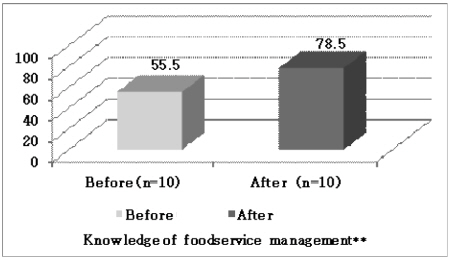References
1. Asano K, Yoon J, Yoon B. Appropriate size and dish combination of nutritional-balanced lunch boxes delivered to children under the government-funded meal service program in Korea. Korean J Community Nutr 2009. 14(5)565–575.
2. Bae EJ, Kwon JH, Yoon HJ, Lee SK. Nutritional status of school lunch supported students in an elementary school. J Korean Diet Assoc 2001. 7(4)349–360.
3. Cho YR. Food sanitary practices and perception of employees in some food services 2000. Chungang University; 44. MS.
4. Choi MK, Choi SH, Lee SI. An assessment of customer satisfaction towards university residence hall foodservice and subjective QOL (Quality of Life): Focused on the university students in Daegu, Gyeongbuk area. Korean J Community Nutr 2009. 14(1)114–122.
5. Gordon A, Briefel R. Feeding low-income children when school is out-the summer food service program: Executive summary 2003. USDA: Economic Research Service;
6. Jeon EK, Bae HJ. Evaluation of sanitation management performance within school foodservice facilities and utilities in Gyeongbuk province. Korean J Food Cookery Sci 2009. 25(1)62–73.
7. Jung HJ, Moon SJ, Lee LH, Yu CH, Paik HY, Yang IS, Moon HK. Evaluation of elementary school foodservice menus on its nutrient contents and diversity of the food served. Korean J Nutr 1997. 30(7)854–869.
8. Kant AK, Schatzkin A, Block G, Ziegler RG, Nestle M. Food group intake patterns and associated nutrient profiled of the US population. J Am Diet Assoc 1991. 91(12)1526–1531.
9. Kim ES. A study on improving the efficiency of the free feeding system for poorly-fed children in Gangwon province 2007b. Gangwon: Development Research Institute; 139–165.
10. Kim HJ, Yoon JS. Food diversity and nutrient intake of elementary school students in Daegu-Kyungbook area. Korean J Community Nutr 2010. 15(3)297–307.
11. Kim MS. Status on foodservice program for low-income children 2007a. National Human Rights Commission of Korea; 127–193.
12. Kim YH, Cho YB. A study on the perception and satisfaction with school food service among High School Students in the Busan and Kyungnam Area. Korean J Culinary Res 2009. 15(2)338–347.
13. Kwon S, Lee KW, Yoon J. Diet of children under the government-funded meal support program in Korea. Nutr Res Pract 2010. 4(6)515–521.
14. Lee HW. An evaluation of the lunch programs for the children in need : Comparison of the parents' program satisfaction among the three types of institutions. J Korean Soc Child Welf 1999. 879–102.
15. Lee JH. Dietary habits and nutrient intakes of children using community food service centers in different family type 2009. Kyunghee University; 36–37.
MS thesis.
16. Lee MS, Lee JY, Yoon SH. Assessment of foodservice management performance at child care centers. Korean J Community Nutr 2006. 11(2)229–239.
17. Lee YE. An analysis on the satisfaction with the quality of school foodservice in Chungbuk province. Korean J Food Cult 2008. 23(1)105–114.
18. Lim YH, Kwak HO. A study on the sanitary management practics of institutional foodservice employees in Daejeon and Chungnam area. Korean J Food Cult 2006. 21(4)381–387.
19. Ministry for Health and Welfare. Dietary action guides for Korean children 2009.
20. Ministry of Health and Welfare & Headquarters for Community Child Center. Current status of community children's center 2011. 5–36.
21. Park JY, Ahn SS, Park HH. A study on differences food hygiene knowledge and practice between houswives and thecontract foodservice employees. Korean J Food Nutr 2006. 19(3)301–310.
22. Park ND. Current status of foodservice and improvement the efficiency of the free feeding system for poorly-fed children in Daejeon 2008. Daejeon Development Institute; 87–88.
23. The Korean Nutrition Society. Dietary Reference Intakes for Koreans 2010. Seoul: Hanareum Publishing Co.; 528–530.
24. Yang IS. Study on satisfaction in school foodservice 2007. Ministry of Education & Human Resources Development report; 4–6.
25. Yang IS, Kim HA, Lee YE, Park MK, Park SY. The development of a quality measurement tool for a contractmanaged hospital foodservice. Korean J Community Nutr 2003. 8(3)319–326.
26. Yang IS, Lee BS, Cha JA, Han KY, Chae IS, Lee JM. Foodservice in institutions 2011. Paju: Kyomunsa Publishing Co.; 71–265.
27. Yoon B, Kwon S, Yoon J. Menu evaluation of meal boxes delivered to children from low-Income families during summer vacation. J East Asian Soc Dietary Life 2011. 21(1)118–124.
28. Yoon J. Study on development the nutrition guideline for low-income children 2007. The Korea Food & Drug Administration report; 159.









